Home
/ Residential and commercial property in Egypt / Egypt’s housing market recovers!
Egypt’s housing market recovers!
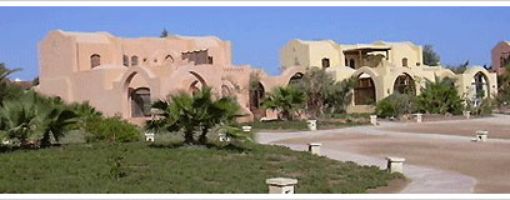
Created: Sep 29, 2010,
modified: Jan 13, 2012,
overall rating: 0.000
Egypt’s housing market has strongly recovered in early-2010, after two years’ slowdown caused by the global crisis. House prices and rents are rising again. Demand from domestic and foreign homebuyers is returning. Property transactions are increasing. New construction projects are underway.
The fast recovery of the Egyptian housing market can be attributed to:
Robust economic growth, with projected GDP growth of 6% in 2010;
Continued demographic growth; a large middle-aged population;
New construction projects, both from the government and the private sector;
Government-initiated real estate auctions, which have fuelled interest in land and real estate prices;
Strong demand from local homebuyers, insulating the local market from the global crisis;
The underdevelopment of Egypt’s mortgage market has shielded the country from the contagion brought by the global financial meltdown.
Real estate prices rose by about 5% in the first quarter of 2010, according to some local real estate agents. In 2010, the size of the housing market is projected to grow by about 14%. House prices are expected to rise by about 10% for the whole year of 2010.
The Egyptian economy grew by 5.3% for the fiscal year to end-June 2010, from 4.7% in FY2008/09 and 7.2% in FY2008/07. In the second quarter of 2010, economic growth accelerated with an annualised GDP growth rate of 5.9%, up from 5.8% in Q1 2010 and 5.1% in Q4 2009. The construction sector grew by an annualised 13.2% and the IT sector by 12% over the same period.
For the fiscal year 2010/11, the Egyptian economy is projected to expand by 5.8% to 6%, based on government estimates.
In the first half of 2010, the price of an apartment in Cairo was around EGP 7,500 (US$1,322) per sq. m., according to local real estate analysts. In new areas of Al-Rhab, Medinat October and Medinat Sheikh Zayed, the average price of apartments was about EGP 5,000 (US$882) per sq. m.
In Maadi, house prices range from EGP 2,721 (US$480) per sq. m to EGP 7,027 (US$1,239) per sq. m. In Zamalek, prices range from EGP7,500 (US$1,322) per sq. m to EGP10,000 (US$1,763) per sq. m. On the other hand, houses at the Sixth of October were priced from EGP 1,700 (US$300) per sq. m to EGP 5,000 (US$882) per sq. m.
In Sharm el Sheik, a newly built property costs about EGP261,800 (US$46,160) while along the Red Sea, properties are priced under EGP436,400 (US$76,943).
By early-2010, Egypt’s real estate market was valued at around EGP47.6 billion (US$270 billion), according to Moustafa El-Haiawan, board chairman of the Mortgage Finance Fund. The real estate sector has grown by 22% annually over the past three years, according to the Ministry of Investment.
The downturn of the past few years should not be understated (though because the fall was ‘after-inflation’, it was less obvious).The following data come from various sources:
Property prices in Egypt rose 13.7% (4.5% in real terms) in 2005
House prices then dropped 0.4% (-4.4% in real terms) in 2006
House prices fell 0.6% (-10.4%) in 2007, according to the 2008 Egypt Housing Survey conducted by Bearing Point Inc, which has a cross-Egypt sample.
House prices fell further in 2008, due to the global crisis.
By end-2009, house prices in the secondary market had fallen by about 37%, in real terms, according to local real estate analysts.
The fast recovery of the Egyptian housing market can be attributed to:
Robust economic growth, with projected GDP growth of 6% in 2010;
Continued demographic growth; a large middle-aged population;
New construction projects, both from the government and the private sector;
Government-initiated real estate auctions, which have fuelled interest in land and real estate prices;
Strong demand from local homebuyers, insulating the local market from the global crisis;
The underdevelopment of Egypt’s mortgage market has shielded the country from the contagion brought by the global financial meltdown.
Real estate prices rose by about 5% in the first quarter of 2010, according to some local real estate agents. In 2010, the size of the housing market is projected to grow by about 14%. House prices are expected to rise by about 10% for the whole year of 2010.
The Egyptian economy grew by 5.3% for the fiscal year to end-June 2010, from 4.7% in FY2008/09 and 7.2% in FY2008/07. In the second quarter of 2010, economic growth accelerated with an annualised GDP growth rate of 5.9%, up from 5.8% in Q1 2010 and 5.1% in Q4 2009. The construction sector grew by an annualised 13.2% and the IT sector by 12% over the same period.
For the fiscal year 2010/11, the Egyptian economy is projected to expand by 5.8% to 6%, based on government estimates.
In the first half of 2010, the price of an apartment in Cairo was around EGP 7,500 (US$1,322) per sq. m., according to local real estate analysts. In new areas of Al-Rhab, Medinat October and Medinat Sheikh Zayed, the average price of apartments was about EGP 5,000 (US$882) per sq. m.
In Maadi, house prices range from EGP 2,721 (US$480) per sq. m to EGP 7,027 (US$1,239) per sq. m. In Zamalek, prices range from EGP7,500 (US$1,322) per sq. m to EGP10,000 (US$1,763) per sq. m. On the other hand, houses at the Sixth of October were priced from EGP 1,700 (US$300) per sq. m to EGP 5,000 (US$882) per sq. m.
In Sharm el Sheik, a newly built property costs about EGP261,800 (US$46,160) while along the Red Sea, properties are priced under EGP436,400 (US$76,943).
By early-2010, Egypt’s real estate market was valued at around EGP47.6 billion (US$270 billion), according to Moustafa El-Haiawan, board chairman of the Mortgage Finance Fund. The real estate sector has grown by 22% annually over the past three years, according to the Ministry of Investment.
The downturn of the past few years should not be understated (though because the fall was ‘after-inflation’, it was less obvious).The following data come from various sources:
Property prices in Egypt rose 13.7% (4.5% in real terms) in 2005
House prices then dropped 0.4% (-4.4% in real terms) in 2006
House prices fell 0.6% (-10.4%) in 2007, according to the 2008 Egypt Housing Survey conducted by Bearing Point Inc, which has a cross-Egypt sample.
House prices fell further in 2008, due to the global crisis.
By end-2009, house prices in the secondary market had fallen by about 37%, in real terms, according to local real estate analysts.
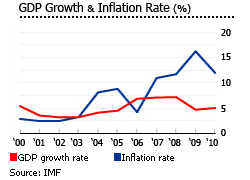
Economic growth strong, but inflation high
One of the consequences of Egypt’s rapid economic growth is high inflation, which remains a major concern.Headline inflation rose to 10.7% in June 2010 from 10.5% the previous month. Core inflation, which excludes prices of fruits and vegetables, and regulated items, was 6.7% in June 2010, almost unchanged from a month earlier, according to the Central Agency for Public Mobilization and Statistics (CAPMAS).
Inflation is expected to ease slightly to 10% in FY2010/11 and to 9% in FY2011/12. Due to soaring commodity prices, inflation reached 18.3% in FY2009/10, more than thrice the GDP growth rate over the same period.
Tourism, which makes up about 16% of GDP, is expected to recover in 2010 as many low-cost airlines offer cheap flights to the country on a daily basis. The tourist sector is projected to grow by 6% in 2010.
In 2009, the unemployment rate was 9.4%, up from 8.7% in 2008, according to the Central Bank of Egypt (CBE). In the first quarter of 2010, the unemployment rate slightly dropped to 9.1%, as the economy picked up.
One of the consequences of Egypt’s rapid economic growth is high inflation, which remains a major concern.Headline inflation rose to 10.7% in June 2010 from 10.5% the previous month. Core inflation, which excludes prices of fruits and vegetables, and regulated items, was 6.7% in June 2010, almost unchanged from a month earlier, according to the Central Agency for Public Mobilization and Statistics (CAPMAS).
Inflation is expected to ease slightly to 10% in FY2010/11 and to 9% in FY2011/12. Due to soaring commodity prices, inflation reached 18.3% in FY2009/10, more than thrice the GDP growth rate over the same period.
Tourism, which makes up about 16% of GDP, is expected to recover in 2010 as many low-cost airlines offer cheap flights to the country on a daily basis. The tourist sector is projected to grow by 6% in 2010.
In 2009, the unemployment rate was 9.4%, up from 8.7% in 2008, according to the Central Bank of Egypt (CBE). In the first quarter of 2010, the unemployment rate slightly dropped to 9.1%, as the economy picked up.
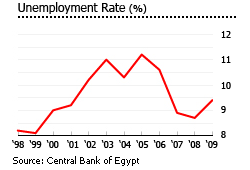
Rising rents and high yields!
Rents vary widely within cities, but have generally been rising in the past months. In Mohandeseen, in the city of Giza, which is attractive to rich locals, rents are soaring. A luxury apartment renting for EGP17,500 (US$3,085) per month in the past six months, are now rented at EGP39,275 (US$6,925) per month.
In Heliopolis, an upscale district of Cairo, monthly rents range from EGP 4,271 (US$753) for a 150 sq. m. apartment to EGP 23,651 (US$4,170) for a 500 sq. m. apartment, based on the 2009Global Property Guide research.
The average rental yield in Egypt was 7.3% in 2009. In Maadi, rental yields are spectacular at an average of 12% in 2009. Although yields are 5% lower than the 2007 Global Property Guide estimates, foreigners still like to live there. Prices start from US$600 per sq. m., to around US$1,000 per sq. m..
Vacancy rates are generally low in Egypt.
Rents vary widely within cities, but have generally been rising in the past months. In Mohandeseen, in the city of Giza, which is attractive to rich locals, rents are soaring. A luxury apartment renting for EGP17,500 (US$3,085) per month in the past six months, are now rented at EGP39,275 (US$6,925) per month.
In Heliopolis, an upscale district of Cairo, monthly rents range from EGP 4,271 (US$753) for a 150 sq. m. apartment to EGP 23,651 (US$4,170) for a 500 sq. m. apartment, based on the 2009Global Property Guide research.
The average rental yield in Egypt was 7.3% in 2009. In Maadi, rental yields are spectacular at an average of 12% in 2009. Although yields are 5% lower than the 2007 Global Property Guide estimates, foreigners still like to live there. Prices start from US$600 per sq. m., to around US$1,000 per sq. m..
Vacancy rates are generally low in Egypt.
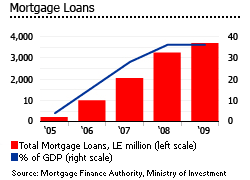
Mortgage market set for take-off?
The Egyptian mortgage market dates to 2001, when Presidential Decree No. 277 created the Mortgage Finance Authority (MFA).Itstill represents less than 1% of GDP.Lending has remained low partly because the complex registration process takes about 6 months to complete. The market now stands at around EGP 4 billion (US$705 million) (early-2010), up from EGP 208 million (US$36.7 million) in 2005.
Most Egyptian and foreign property buyers pay cash. Cash purchases represented 57% of all property transactions in Egypt from 2003 to 2008, according to the 2008 Egypt Housing Survey.
However by mid-2010 there were 11 mortgage finance companies (MFCs), up from only 2 in 2005. The government plans to expand the mortgage market to EGP 10 billion (US$1.76 billion) in the next 3 years, according to Moustafa El-Haiawan, board chairman of Egypt´s Mortgage Finance Fund, which will subsidize about 10,000 housing units in 2010, and 65,000 units by 2012. Low-income households with a maximum monthly income of around EGP20,000 may qualify for the subsidies.
The average term period for mortgage loans was 16.1 years, according to Investment Minister Mahmoud Mohieldin.
Currently, the average mortgage interest rate is 12.45% p.a.. The CBE’s overnight deposit rate was 8.25% in July 2010, the lowest since November 2006. The central bank last cut its benchmark rate in September 2009.
Analysts predict that the central bank will keep its key rate steady for the rest of 2010.
The Egyptian mortgage market dates to 2001, when Presidential Decree No. 277 created the Mortgage Finance Authority (MFA).Itstill represents less than 1% of GDP.Lending has remained low partly because the complex registration process takes about 6 months to complete. The market now stands at around EGP 4 billion (US$705 million) (early-2010), up from EGP 208 million (US$36.7 million) in 2005.
Most Egyptian and foreign property buyers pay cash. Cash purchases represented 57% of all property transactions in Egypt from 2003 to 2008, according to the 2008 Egypt Housing Survey.
However by mid-2010 there were 11 mortgage finance companies (MFCs), up from only 2 in 2005. The government plans to expand the mortgage market to EGP 10 billion (US$1.76 billion) in the next 3 years, according to Moustafa El-Haiawan, board chairman of Egypt´s Mortgage Finance Fund, which will subsidize about 10,000 housing units in 2010, and 65,000 units by 2012. Low-income households with a maximum monthly income of around EGP20,000 may qualify for the subsidies.
The average term period for mortgage loans was 16.1 years, according to Investment Minister Mahmoud Mohieldin.
Currently, the average mortgage interest rate is 12.45% p.a.. The CBE’s overnight deposit rate was 8.25% in July 2010, the lowest since November 2006. The central bank last cut its benchmark rate in September 2009.
Analysts predict that the central bank will keep its key rate steady for the rest of 2010.
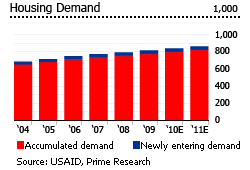
Strong foreign and local housing demand
In 2009, housing demand was about 816,000 units, based on studies conducted by USAID and Prime Research.
Both foreign and local demand is rising rapidly:
With over 500,000 marriages annually, there is a strong demand for housing, especially first time buyers.
Egypt’s economic growth is rapid
Foreign demand from second homeowners, is rising, mainly due to the country’s tax-friendly laws, which charge no tax to non-resident property owners, aiming to encourage investment from overseas property buyers.
In 2009, housing demand was about 816,000 units, based on studies conducted by USAID and Prime Research.
Both foreign and local demand is rising rapidly:
With over 500,000 marriages annually, there is a strong demand for housing, especially first time buyers.
Egypt’s economic growth is rapid
Foreign demand from second homeowners, is rising, mainly due to the country’s tax-friendly laws, which charge no tax to non-resident property owners, aiming to encourage investment from overseas property buyers.
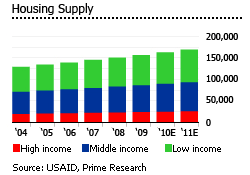
Shortage of affordable housing
The Egyptian housing market faces a supply shortage, especially in the low-income segment, which has a shortage of about 40,000 units per year. Over 5 million people have been pushed into the cemeteries of Cairo’s City of the Dead.
About 90% of the country’s housing supply is built informally, while only 10% is built by professional property developers. More than 11 million people, out of the country’s total population of almost 82 million, live in informal slum settlements.
About 44.4% of Egypt’s housing stock is occupied by owners, while about 35.7% of the housing stock is rented. Other tenure types are gifts, and in–kind privileges (14.1%), and public housing (5.5%).
To address the problem, the Ministry of Investment has introduced a program to subsidized low-income housing, by giving priority to first time buyers. Debt finance has been extended to low-income families through the Guarantee and Subsidy Fund (GSF), providing up to 15% of the value of a residence.
Investment hotspots
The luxury, foreign and second-home property market is rather different from the gritty realities we have been talking about in much of this report.For this market, the buying opportunities in Egypt – and particularly the newly-built opportunities - can be conceptually divided into three areas: Cairo, the Red Sea, and the Mediterranean Coast.
1. Cairo
Emaar’s Uptown Cairo
The EGP 12 billion (US$2.2 billion) Uptown Cairo was being constructed by the developer Emaar Misr. The development offers several residential villages, a golf course, malls, sports and leisure facilities, as well as a business park. This is the first wholly foreign-owned developer to enter the Egyptian market.
Katameya Heights
The super-luxurious Katameya Heights launched prior to Uptown Cairo, covers an area of about 1.5 million sq. m. Katameya Heights, introduced in 1997, were purely local. Formerly a stretch of desert, Katameya Heights is now a large suburban area, with large houses, and has attracted enormous interest. The resort offers marvelous clubhouse, beautifully designed golf course and luxurious villas.
Rehab City
Rehab City, a real estate development located in New Cairo, is being developed by Talaat Moustafa Group (TMG). The development is located on the Cairo-Suez road. It offers many shopping malls and a cinema complex. Rehab City is preferred by many upscale locals.
New Cairo City
Emaar Misr is also building a 5,000-home 3.8 m sq. m. project, New Cairo City. The development is considered a new extension to Cairo, the capital. New Cairo City, when completed, is expected to feature several villages offering gated villas, townhouses and high-rise apartments.
Mivida is a EGP 6 billion (US$1.1 billion) residential development located at the fifth district in the New Cairo City. The 3.8 million sq. m. development will feature 5,000 apartments, townhouses and villas.
2. Red Sea
Sharm el Sheikh
Sharm el Sheikh is now the country’s most luxurious and attractive resort, newer and more upscale than Hurghada, host to 5-star hotels and international conferences. Sharm has a vibrant night life, and boasts many nightclubs, the longest continuous bar in the Middle East, and a marina which can handle private yachts and sailboats. Zoning laws limit building heights (limited to three stories), which has prevented the surroundings’ natural beauty from being spoiled by high rises.
Sharm’s development has been led by tourism, though hotels such as the Ritz-Carlton have sold private villas. New residential developments tend to follow this hotel-based pattern, such as the just-completed Sierra Resort Nabq Bay; the Laguna Vista Residence in Naqb Bay; the Carlton Resort, Hadava. Fully residential is Montazah in Ras Nasranr.
Hurghada
Hurghada is the most popular seaside resort in Egypt, though it is overcrowded and now slightly seedy. Hurghada has an international airport with direct flights to major European countries, as well as flights to Cairo. The city is divided into three parts: Downtown (the old part); Sekalla (the city center); and El Memsha (the modern part).
Sahl Hasheesh
Eighteen kilometers South of Hurghada lies Sahl Hasheesh Bay, where a purpose-built resort flanking 12.5 kilometres of sandy beach is being built. Covering 32 million square metres, by the time it is completed in 2014 Sahl Hasheesh will have 20 5-star hotels and 8 golf courses. The Egyptian Resorts Company (ERC) owns the exclusive development rights.
Port Ghalib
Much further south near Marsah Alam, two and a half hours from Luxor, the Port Ghalib project is being developed by Al Kharafi Group of Kuwait along 18 kilometres of shoreline. It opened in November 2007, with around 100 properties for sale, and a further 350 in the pipeline. Marsah Alam has a newly-built international airport, an international convention centre, a man-made lagoon, and a multiplicity of sports facilities. A marina and the usual mix of hotel/residential mix are planned.
3. Mediterranean Coast
Marassi
The Marassi resort, worth around EGP 9.92 billion (US$1.74 billion), is being developed by Emaar. It is located on a 7-km coastline at Sidi Abdel Rahman on the Mediterranean near El Alamein. Marassi resort will offer up to 3,000 hotel rooms, luxury villas, chalets, a marina, an 18-hole golf course and healthcare facilities.
Almaza Bay
Travco, the main German tour, is building Almaza Bay at Marsa Matruh on the Mediterranean between Alexandria and Libya. The Almaza Bay Resort has a total area of 5 million sq. m. and boasts about 2.5 km of flawless beachfront in one of the most pristine beaches in the world. The three major developments in Almaza Bay include the Jaz Almaza Beach Resort, Jaz Crystal Resort and Jaz Oriental Resort.
by Global Property Guide
The Egyptian housing market faces a supply shortage, especially in the low-income segment, which has a shortage of about 40,000 units per year. Over 5 million people have been pushed into the cemeteries of Cairo’s City of the Dead.
About 90% of the country’s housing supply is built informally, while only 10% is built by professional property developers. More than 11 million people, out of the country’s total population of almost 82 million, live in informal slum settlements.
About 44.4% of Egypt’s housing stock is occupied by owners, while about 35.7% of the housing stock is rented. Other tenure types are gifts, and in–kind privileges (14.1%), and public housing (5.5%).
To address the problem, the Ministry of Investment has introduced a program to subsidized low-income housing, by giving priority to first time buyers. Debt finance has been extended to low-income families through the Guarantee and Subsidy Fund (GSF), providing up to 15% of the value of a residence.
Investment hotspots
The luxury, foreign and second-home property market is rather different from the gritty realities we have been talking about in much of this report.For this market, the buying opportunities in Egypt – and particularly the newly-built opportunities - can be conceptually divided into three areas: Cairo, the Red Sea, and the Mediterranean Coast.
1. Cairo
Emaar’s Uptown Cairo
The EGP 12 billion (US$2.2 billion) Uptown Cairo was being constructed by the developer Emaar Misr. The development offers several residential villages, a golf course, malls, sports and leisure facilities, as well as a business park. This is the first wholly foreign-owned developer to enter the Egyptian market.
Katameya Heights
The super-luxurious Katameya Heights launched prior to Uptown Cairo, covers an area of about 1.5 million sq. m. Katameya Heights, introduced in 1997, were purely local. Formerly a stretch of desert, Katameya Heights is now a large suburban area, with large houses, and has attracted enormous interest. The resort offers marvelous clubhouse, beautifully designed golf course and luxurious villas.
Rehab City
Rehab City, a real estate development located in New Cairo, is being developed by Talaat Moustafa Group (TMG). The development is located on the Cairo-Suez road. It offers many shopping malls and a cinema complex. Rehab City is preferred by many upscale locals.
New Cairo City
Emaar Misr is also building a 5,000-home 3.8 m sq. m. project, New Cairo City. The development is considered a new extension to Cairo, the capital. New Cairo City, when completed, is expected to feature several villages offering gated villas, townhouses and high-rise apartments.
Mivida is a EGP 6 billion (US$1.1 billion) residential development located at the fifth district in the New Cairo City. The 3.8 million sq. m. development will feature 5,000 apartments, townhouses and villas.
2. Red Sea
Sharm el Sheikh
Sharm el Sheikh is now the country’s most luxurious and attractive resort, newer and more upscale than Hurghada, host to 5-star hotels and international conferences. Sharm has a vibrant night life, and boasts many nightclubs, the longest continuous bar in the Middle East, and a marina which can handle private yachts and sailboats. Zoning laws limit building heights (limited to three stories), which has prevented the surroundings’ natural beauty from being spoiled by high rises.
Sharm’s development has been led by tourism, though hotels such as the Ritz-Carlton have sold private villas. New residential developments tend to follow this hotel-based pattern, such as the just-completed Sierra Resort Nabq Bay; the Laguna Vista Residence in Naqb Bay; the Carlton Resort, Hadava. Fully residential is Montazah in Ras Nasranr.
Hurghada
Hurghada is the most popular seaside resort in Egypt, though it is overcrowded and now slightly seedy. Hurghada has an international airport with direct flights to major European countries, as well as flights to Cairo. The city is divided into three parts: Downtown (the old part); Sekalla (the city center); and El Memsha (the modern part).
Sahl Hasheesh
Eighteen kilometers South of Hurghada lies Sahl Hasheesh Bay, where a purpose-built resort flanking 12.5 kilometres of sandy beach is being built. Covering 32 million square metres, by the time it is completed in 2014 Sahl Hasheesh will have 20 5-star hotels and 8 golf courses. The Egyptian Resorts Company (ERC) owns the exclusive development rights.
Port Ghalib
Much further south near Marsah Alam, two and a half hours from Luxor, the Port Ghalib project is being developed by Al Kharafi Group of Kuwait along 18 kilometres of shoreline. It opened in November 2007, with around 100 properties for sale, and a further 350 in the pipeline. Marsah Alam has a newly-built international airport, an international convention centre, a man-made lagoon, and a multiplicity of sports facilities. A marina and the usual mix of hotel/residential mix are planned.
3. Mediterranean Coast
Marassi
The Marassi resort, worth around EGP 9.92 billion (US$1.74 billion), is being developed by Emaar. It is located on a 7-km coastline at Sidi Abdel Rahman on the Mediterranean near El Alamein. Marassi resort will offer up to 3,000 hotel rooms, luxury villas, chalets, a marina, an 18-hole golf course and healthcare facilities.
Almaza Bay
Travco, the main German tour, is building Almaza Bay at Marsa Matruh on the Mediterranean between Alexandria and Libya. The Almaza Bay Resort has a total area of 5 million sq. m. and boasts about 2.5 km of flawless beachfront in one of the most pristine beaches in the world. The three major developments in Almaza Bay include the Jaz Almaza Beach Resort, Jaz Crystal Resort and Jaz Oriental Resort.
by Global Property Guide
Your Rating:
Overall rating: 0.000
Totally voted: 0
Comments
Login/Registration
Weather in:
Exchange Rates
1 USD = 16.200 LE
1 EUR = 18.040 LE
News
-
IMF loan expected next month
Apr 22, 2013, rating: 3.000, 3 votes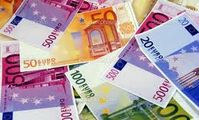 Egypt may secure an International Monetary Fund loan agreement in about amonth, state news agency MENA reported, quoting "informed" sources ...
Egypt may secure an International Monetary Fund loan agreement in about amonth, state news agency MENA reported, quoting "informed" sources ...
-
Egypt received 11 million tourists in 2012 and aims to boost that number to 14 million in 2013.
Jan 22, 2013, rating: 3.000, 2 votes
Egypt received 11 million tourists in 2012 and aims to boost that number to 14 million in 2013.
-
Egypt limits travelers leaving country to US$10,000 in cash
Dec 26, 2012, rating: 3.250, 4 votes Egypt has banned travelers from carrying more than US$10,000 in foreigncurrency cash in or out of the country ...
Egypt has banned travelers from carrying more than US$10,000 in foreigncurrency cash in or out of the country ...
-
National Coalition on Climate Change for Egypt is born
Nov 30, 2012, rating: 5.000, 1 votes The global COP18 conference on climate change opens in Doha Monday.About 17,000 participants from all over the world ...
The global COP18 conference on climate change opens in Doha Monday.About 17,000 participants from all over the world ...
-
Judgment for sexual harassment
Nov 14, 2012, rating: 3.600, 5 votes A man was sentenced to two years in prison and fined LE 2,000 for sexually harassing a woman, an ...
A man was sentenced to two years in prison and fined LE 2,000 for sexually harassing a woman, an ...
-
Scientists are enthusiastic about hydrogen's green applications
Nov 13, 2012, rating: 4.000, 3 votes
As fossil fuel reserves decrease, many countries are turning to hydrogen as one of the main sources of alternative energy ...








